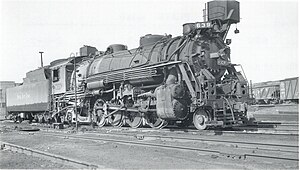 | |||||||||||||||||||
 USRA Light Mikado No. 639 from the Nickel Plate Road | |||||||||||||||||||
| |||||||||||||||||||
| |||||||||||||||||||
| |||||||||||||||||||
Under the Whyte notation for the classification of steam locomotives, 2-8-2 represents the wheel arrangement of two leading wheels on one axle, usually in a leading truck, eight powered and coupled driving wheels on four axles and two trailing wheels on one axle, usually in a trailing truck. This configuration of steam locomotive is most often referred to as a Mikado,[1] frequently shortened to Mike.[2]
It was also at times referred to on some railroads in the United States as the McAdoo Mikado and, during World War II, the MacArthur.[3]
The notation 2-8-2T indicates a tank locomotive of this wheel arrangement, the "T" suffix indicating a locomotive on which the water is carried in tanks mounted on the engine rather than in an attached tender.
- ^ "2-8-2 "Mikado" Locomotives in the USA".The name comes the first locomotives of this wheel arrangement, made by Baldwin in 1893 for Nihon Tetsudo (Japan Railways), a private railway at the time.
- ^ "Steam Locomotive Glossary". Railway Technical Web Pages. 28 June 2007. Archived from the original on 17 May 2013. Retrieved 8 February 2008.
- ^ "Ask Trains for August 2006". Kalmbach Publishing. Retrieved 29 January 2008.